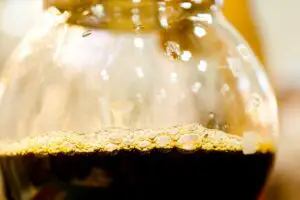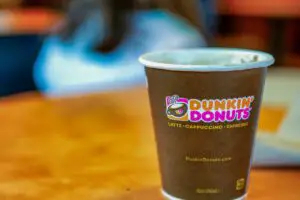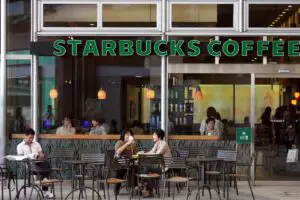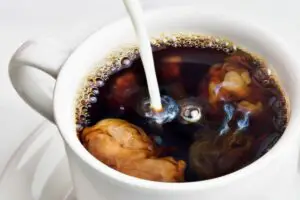*This post may contain affiliate links. As an Amazon Associate we earn from qualifying purchases.
Ah, Starbucks, the McDonald’s of coffee! You can’t walk a block in any major city without bumping into that familiar green mermaid. But have you ever wondered why some coffee purists turn their noses up at Starbucks like it’s a week-old, burnt batch of beans?
Well, dear reader, buckle up because we’re about to dive deep into the world of coffee snobbery and find out why they’re hating on our favorite caffeine dealer.
You see, Starbucks is a global powerhouse in the coffee industry, which is both a blessing and a curse. As much as it has made our lives easier by providing us with our daily dose of caffeine, it has also attracted the ire of some coffee aficionados.
In this article, we’ll explore the nitty-gritty details of what makes Starbucks a target for criticism, from the quality of their beans to their impact on the environment.
But before we go further, let me assure you that I’m not here to bash Starbucks or ruin your beloved morning routine. I’m a proud patron of Starbucks, and with three kids at home, trust me, I need all the coffee I can get!
My five-year-old daughter’s incessant questions about unicorns, my eight-year-old son’s LEGO minefields, and my twelve-year-old’s newfound teenage angst make my trips to Starbucks nothing short of a lifesaver.
So, let’s embark on this caffeine-fueled journey together, and maybe we’ll all learn something new!
Key Takeaways
In this article, we will explore the reasons behind the disdain many coffee purists have for Starbucks. Here’s a summary of the key points we will discuss:
- Quality of coffee beans: Starbucks often uses lower-quality beans and blends to meet high demand, while coffee purists prefer single-origin beans from smaller, more sustainable farms.
- Over-roasting of beans: Starbucks is known for its dark roasts, which can mask the unique flavors of the beans, while coffee purists prefer lighter roasts that showcase the beans’ true character.
- Artificial ingredients in drinks: Starbucks’ flavored drinks often contain artificial ingredients and sweeteners, while coffee purists appreciate natural flavorings and simple recipes.
- Dilution of coffee culture: Starbucks’ global dominance has led to a homogenization of coffee culture, whereas coffee purists value the diversity and authentic experiences found in local coffee shops.
- Loss of the “third place” concept: The original Starbucks vision of creating a welcoming “third place” has been overshadowed by the focus on convenience and speed, which can detract from the overall coffee experience.
- Impact on local coffee shops: Starbucks’ expansion can lead to the closure of smaller, independent coffee shops, which are often more aligned with coffee purists’ values.
- Focus on convenience in coffee shops: Starbucks prioritizes speed and efficiency, which can compromise the craftsmanship and artistry involved in coffee-making.
- Environmental impact: Starbucks’ use of single-use cups, water consumption, and large-scale coffee farming practices raise environmental concerns, while coffee purists often prefer more sustainable practices.
- Premium pricing: Starbucks’ drinks are often more expensive than those at local coffee shops, leading coffee purists to question whether the higher prices are justified given the perceived compromises in quality.
The Quality of Starbucks Coffee Beans
Picture this: You’re a coffee connoisseur, sipping your carefully crafted cup of single-origin, shade-grown, fair-trade coffee. Then, along comes your coworker, proudly flaunting their Venti Caramel Frappuccino® with extra whipped cream.
You can’t help but feel a little judgy, right?
The use of over-roasted beans to maintain consistency
You see, Starbucks has built its empire on consistency. That means that they need to make sure that your cup of joe tastes the same, whether you’re in Seattle or Singapore.
To achieve this, they often over-roast their beans, which some coffee purists argue sacrifices the beans’ unique flavors and characteristics. It’s like turning a Michelin-star meal into a fast-food burger—it might taste alright, but you’re missing out on the nuances that make it truly special.
Now, I’m no coffee snob, but I do appreciate the finer things in life, like a perfectly brewed cup of coffee that doesn’t taste like burnt toast. But when I’m running late to my daughter’s ballet recital and need a caffeine fix, I’ll take what I can get.
And hey, at least I can count on my Starbucks order to be consistent, right?
Starbucks’ preference for Arabica over more diverse bean varieties
Did you know that there are over 100 species of coffee plants in the world? Yet, Starbucks mainly sticks to Arabica beans. Sure, Arabica is the most popular and widely consumed variety, but it’s like eating nothing but chicken nuggets your whole life—there’s so much more out there!
Coffee purists argue that by focusing on Arabica, Starbucks is contributing to the homogenization of coffee culture and overlooking the rich diversity of bean varieties.
It’s a bit like going to an all-you-can-eat buffet and only eating breadsticks (although let’s be honest, breadsticks are delicious).
Mass production leading to potential quality compromises
In the world of coffee, bigger isn’t always better. Starbucks sources tons of coffee beans to keep up with our insatiable demand for caffeine, which can sometimes lead to quality compromises.
Coffee purists argue that smaller, independent roasters are more likely to focus on quality over quantity, which results in a better-tasting cup of coffee. It’s kind of like comparing mass-produced chocolate chip cookies to your grandma’s secret recipe—there’s just no contest!
The impact of large-scale coffee farming on bean quality
When you’re running a coffee empire, you need a lot of beans. And that means large-scale coffee farming is a must for Starbucks.
However, this practice can have a negative impact on bean quality.
Coffee purists argue that smaller farms, which often use more sustainable and organic practices, are more likely to produce higher-quality beans. So, while Starbucks gets points for convenience, it might lose a few for bean quality.
Coffee Brewing Techniques at Starbucks
Standardized brewing methods and lack of manual brewing options
When it comes to brewing coffee, Starbucks is like the Swiss Army knife of the coffee world—it’s got all the gadgets and gizmos you could ever need. But, there’s one thing it’s missing: manual brewing options.
You know, the kind that makes you feel like a coffee scientist as you carefully measure and time every step of the process.
| Starbucks Brewing Methods | Manual Brewing Options |
|---|---|
| Espresso Machine | Pour-over |
| Drip Coffee Maker | French Press |
| Cold Brew System | AeroPress |
| Siphon |
While Starbucks’ machines can churn out a consistent cup of coffee, they lack the precision and control that manual brewing methods offer.
For coffee purists, this is like painting by numbers instead of creating a masterpiece from scratch.
Over-extraction issues due to automated machines
Automated coffee machines are great for speed and consistency, but they can sometimes lead to over-extraction. That’s when the water spends too much time with the coffee grounds, and they start to feel a little clingy.
The result is a bitter, over-extracted cup of coffee.
Now, I’m no coffee expert, but I know that when my coffee tastes like someone’s been using it to clean a barbecue grill, something’s gone wrong. Coffee purists argue that manual brewing methods, like the pour-over or French press, give you more control over the extraction process, resulting in a better-tasting cup of coffee.
Limited control over water temperature and brewing time
When you’re in a hurry, you probably don’t have time to worry about the exact temperature of your coffee water or how long it’s been brewing. But for coffee purists, these details are crucial to creating the perfect cup.
And unfortunately, Starbucks’ machines don’t always offer the same level of control.
For example, the ideal water temperature for brewing coffee is between 195°F and 205°F. Too hot, and your coffee will taste bitter; too cold, and it’ll be under-extracted. Starbucks’ machines are calibrated to maintain a consistent temperature, but it might not be the optimal temperature for every type of bean.
| Ideal Brewing Temperature | Potential Issues |
|---|---|
| 195°F – 205°F | Bitterness (too hot) or under-extraction (too cold) |
As for brewing time, manual methods like the AeroPress or Chemex allow you to time the process to the second, ensuring you get the most out of your beans.
Starbucks’ machines, on the other hand, are all about speed and efficiency—which is great when you’re running late, but not so great when you’re looking for a nuanced cup of coffee.
The impact of these techniques on coffee flavor and quality
All these factors—over-roasting, large-scale farming, automated brewing—can have a significant impact on the flavor and quality of your Starbucks coffee. And while it might still be good enough to help you survive the chaos of raising three kids, it’s not going to win any coffee awards anytime soon.
Coffee purists argue that by focusing on consistency and efficiency, Starbucks sacrifices the artistry and craftsmanship that make coffee such a unique and enjoyable experience.
Coffee Drink Additives and Flavors
The abundance of flavored syrups and sweeteners
Raise your hand if you’ve ever been judged for ordering a coffee that sounds more like a dessert menu. You know, the ones with more syrup than actual coffee.
Starbucks is famous for its wide range of flavored syrups and sweeteners, which can turn even the most bitter cup of coffee into a sweet treat.
| Popular Starbucks Syrups |
|---|
| Caramel |
| Vanilla |
| Hazelnut |
| Toffee Nut |
| Pumpkin Spice |
But for coffee purists, these additives are nothing more than distractions from the true essence of coffee. It’s like slathering a gourmet steak in ketchup—sure, some people might think that it tastes good, but they’re missing out on the subtleties that make it special.
The masking of coffee’s natural flavors with additives
By adding all these syrups and sweeteners, Starbucks is essentially masking the natural flavors of their coffee. You might still get a hint of the flavor, but you’re missing out on the full experience.
Coffee purists argue that the best way to appreciate a cup of coffee is to taste it in its purest form—black, with no additives. This allows you to savor the unique flavor profile of the beans and appreciate the craftsmanship that went into creating your cup of joe.
The use of artificial ingredients in some Starbucks drinks
As if the syrups and sweeteners weren’t enough, some Starbucks drinks also contain artificial ingredients. These can range from preservatives and colorings to artificial flavors and sweeteners.
| Artificial Ingredients in Starbucks Drinks | Potential Concerns |
|---|---|
| Preservatives | Alters taste, potential health concerns |
| Colorings | Unnatural appearance, health concerns |
| Artificial flavors | Alters taste, potential health concerns |
| Artificial sweeteners | Alters taste, potential health concerns |
For coffee purists, these artificial ingredients are a big no-no. They argue that a truly great cup of coffee shouldn’t need any chemical enhancements to make it enjoyable. It’s like going to an art gallery and finding out all the paintings have been digitally altered—it just doesn’t feel as authentic.
The dilution of coffee culture due to the popularity of flavored drinks
The popularity of Starbucks and its flavored drinks has undoubtedly had an impact on coffee culture. For some, this is a positive thing, as it’s introduced more people to the world of coffee and helped make it a daily ritual for millions of people (myself included).
However, coffee purists argue that this has also led to a dilution of coffee culture, as people are more focused on the sweet treats than the actual coffee.
The Starbucks Atmosphere and Coffee Shop Experience
The loss of the “third place” concept in some Starbucks locations
When Starbucks first started, it aimed to be a “third place”—a spot between home and work where people could gather, relax, and enjoy a cup of coffee. In some ways, it succeeded, as Starbucks locations have become community hubs and meeting spots for people around the world.
But as Starbucks has grown, some locations have lost that cozy, welcoming atmosphere. Instead, they’ve become more like fast-food joints with coffee, focusing on speed and efficiency at the expense of the customer experience.
It’s like going to your favorite mom-and-pop diner and finding out it’s been turned into a McDonald’s—it’s just not the same.
The impact of Starbucks’ rapid expansion on local coffee shops
As Starbucks continues to expand, it’s not just the atmosphere of its own stores that’s affected—it’s also the local coffee shops that find themselves competing with the coffee giant.
Coffee purists argue that this rapid expansion has led to a homogenization of coffee shop culture, as Starbucks’ influence spreads and smaller, independent shops struggle to keep up.
The role of Starbucks in creating a coffee shop culture focused on convenience
There’s no denying that Starbucks has played a huge role in shaping modern coffee shop culture. And while it’s made our lives more convenient by providing us with our daily caffeine fix, it’s also shifted the focus away from the art and craft of coffee.
Instead of being a place where people go to savor their coffee and appreciate the craftsmanship that went into creating it, coffee shops are now more focused on convenience and speed.
The importance of supporting local coffee shops and maintaining diversity in the industry
Despite the issues that coffee purists have with Starbucks, it’s important to recognize the role it has played in making coffee a daily ritual for millions of people. But that doesn’t mean we should forget about the local coffee shops that offer a more unique and authentic experience.
| Reasons to Support Local Coffee Shops | Benefits |
|---|---|
| Unique Atmosphere | More personalized and cozy experience |
| Craftsmanship | Attention to detail and focus on coffee quality |
| Community | Supports local businesses and fosters connections |
| Diversity | Keeps coffee culture interesting and varied |
By supporting local coffee shops, we can help maintain diversity in the coffee industry and ensure that the art and craft of coffee-making don’t get lost in the sea of Frappuccinos.
So next time you’re craving a caffeine fix, why not skip Starbucks and give your local coffee shop a try? You might just discover a new favorite—and I promise, your kids won’t even notice the difference.
The Environmental Impact of Starbucks
The use of single-use cups and plastic waste
One of the biggest environmental concerns surrounding Starbucks is the use of single-use cups and the resulting plastic waste. With millions of coffee drinkers getting their daily fix, that’s a lot of cups ending up in landfills or littering our streets.
| Environmental Concerns | Impact |
|---|---|
| Single-use cups | Landfills, pollution, resource usage |
| Plastic waste | Pollution, harm to wildlife |
To their credit, Starbucks has taken steps to address this issue, such as offering reusable cups and encouraging customers to bring their own. However, there’s still a long way to go before we can call Starbucks an eco-friendly coffee shop.
The water consumption in Starbucks’ coffee production
Another environmental concern related to Starbucks is the water consumption involved in its coffee production. From growing the beans to brewing the coffee, it takes a lot of water to keep the Starbucks machine running.
| Water Usage in Coffee Production | Impact |
|---|---|
| Growing beans | Depletion of water sources |
| Brewing coffee | High water usage |
While Starbucks has implemented some water-saving initiatives in its stores, coffee purists argue that smaller, more sustainable coffee shops and roasters may be better for the environment in the long run.
The impact of Starbucks’ coffee farming practices on local ecosystems
As we’ve mentioned before, Starbucks sources its beans from large-scale coffee farms. While this is necessary to meet the high demand for coffee, it can also have a negative impact on local ecosystems.
| Coffee Farming Impact | Local Ecosystem Consequences |
|---|---|
| Large-scale farming | Deforestation, loss of biodiversity, pollution |
Coffee purists argue that supporting smaller, sustainable coffee farms can help mitigate these environmental issues, while also providing a more unique and high-quality product.
Starbucks’ efforts to improve its environmental impact
Despite these concerns, Starbucks has made efforts to improve its environmental impact. They’ve introduced initiatives such as LEED-certified stores, the Starbucks Greener Apron program, and ethical sourcing practices.
| Starbucks’ Environmental Initiatives | Goals & Benefits |
|---|---|
| LEED-certified stores | Energy efficiency, reduced emissions |
| Greener Apron program | Employee education, sustainable practices |
| Ethical sourcing | Fair labor practices, sustainable farming |
While Starbucks still has room for improvement, it’s important to acknowledge the steps they’ve taken so far. And who knows, maybe one day we’ll be able to enjoy our coffee without any guilt—or at least without feeling like we’re single-handedly destroying the planet.
The Price of Starbucks Coffee
One common complaint about Starbucks is the premium pricing of their drinks. It’s like going to a movie theater and paying $5 for a small soda—you know it’s overpriced, but you still fork over the cash because it’s part of the experience.
With so many drinks and add-ons, a trip to Starbucks can quickly become a pricey affair.
| Starbucks Pricing | Impact on Consumers |
|---|---|
| Premium pricing | Higher costs, less accessible for some people |
Coffee purists argue that the high prices at Starbucks aren’t justified, given the compromises they make in terms of coffee quality and craftsmanship. Instead, they suggest supporting local coffee shops that offer a better value for your money while still delivering a top-notch cup of coffee.
The cost of Starbucks compared to local coffee shops
When comparing the cost of Starbucks to that of local coffee shops, it’s important to consider both the price and the value you’re getting. While Starbucks might be more expensive in terms of dollar amount, you’re also paying for the convenience, brand recognition, and consistency that come with it.
| Starbucks vs. Local Coffee Shops | Price & Value Considerations |
|---|---|
| Starbucks | Convenience, brand recognition, consistency |
| Local Coffee Shops | Quality, craftsmanship, unique experience |
The perceived value of Starbucks drinks
Another factor to consider when looking at the price of Starbucks is the perceived value of their drinks. With their fancy names, customizable options, and seasonal offerings, Starbucks has created an illusion of luxury that customers are willing to pay for.
| Starbucks’ Perceived Value | Factors Contributing to Luxury Image |
|---|---|
| Customizable drinks | Personalization, uniqueness |
| Seasonal offerings | Novelty, limited availability |
| Fancy names | Prestige, sophistication |
Deciding whether Starbucks is worth the price
Ultimately, whether or not Starbucks is worth the price comes down to personal preference. If you value the convenience, consistency, and caffeine buzz that Starbucks provides, you might be willing to overlook the higher prices and potential compromises in quality.
But if you’re a coffee purist who’s all about the art and craft of coffee, you might be better off seeking out a local coffee shop that shares your passion.
Conclusion
So there you have it—our deep dive into the world of Starbucks and why it gets so much hate from coffee purists. Whether you agree or disagree with their points, it’s important to remember that at the end of the day, we’re all just looking for a delicious cup of coffee to help us get through our busy lives.
And if that means sipping on a caramel macchiato while your kids run circles around you, then so be it. Just remember to give your local coffee shop a try every now and then—you never know what hidden gems you might find.
| Summary of Starbucks Concerns | Potential Alternatives |
|---|---|
| Quality of coffee beans | Local coffee shops, single-origin beans |
| Over-roasting of beans | Lighter roasts, artisanal roasters |
| Artificial ingredients in drinks | Natural flavorings, simple recipes |
| Dilution of coffee culture | Supporting authentic coffee experiences |
| Loss of the “third place” concept | Frequenting cozy, welcoming cafes |
| Impact on local coffee shops | Patronizing independent businesses |
| Focus on convenience in coffee shops | Appreciating craftsmanship in coffee |
| Environmental impact | Sustainable practices, reusable cups |
| Premium pricing | Weighing price vs. value |
No matter where you stand in the Starbucks debate, it’s clear that the coffee giant has had a significant impact on our lives and the way we consume coffee. As long as we keep the conversation going, and continue to explore and appreciate the wonderful world of coffee, we can all find our own personal coffee nirvana.
And hey, maybe we can even find some common ground over a cup of Pumpkin Spice Latte—just don’t tell the coffee purists I said that.









